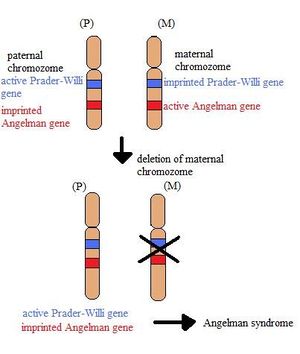Angelman Syndrome: Difference between revisions
From WikiLectures
m (moved Angelman syndrome to Angelman Syndrome: typo) |
mNo edit summary |
||
| (2 intermediate revisions by 2 users not shown) | |||
| Line 10: | Line 10: | ||
* | * | ||
* This warning note is automatically inserted by inserting the template {{subst:Inserted article}}. | * This warning note is automatically inserted by inserting the template {{subst:Inserted article}}. | ||
--------------------------------------------------------------------------------------------------------------> | -------------------------------------------------------------------------------------------------------------->{{Was checked| 20120114185235 | [[User:OSeda|Ondřej Šeda, MD, PhD]]|9634}} | ||
{{Was checked| | |||
__NOTOC__<noinclude>{{Dictionary | __NOTOC__<noinclude>{{Dictionary | ||
|eng=Angelman syndrome}}</noinclude> | |eng=Angelman syndrome}}</noinclude> | ||
[[File:Angelman.jpg|thumb|''Chromosome 15'' - '''Angelman syndrome''']] | [[File:Angelman.jpg|thumb|''Chromosome 15'' - '''Angelman syndrome''']] | ||
*This syndrome is caused by the loss of function of ''gene UBE3A'' - physiologically, just the maternal copy of this gene is functional (the paternal copy is imprinted, i.e. epigenetically silenced). Thus loss of the maternal gene causes this syndrome. The critical genomic region of this disorder is located on chromosome 15 (The Prader-Willi/Angelman Critical Region- PWACR; 15q11-q13). This genetic disorder is connected especially with the nervous system. Children are affected in their early age. | * This syndrome is caused by the '''loss of function of ''[[gene]] UBE3A''''' - physiologically, just the maternal copy of this gene is functional (the paternal copy is imprinted, i.e. [[Epigenetics|epigenetically]] silenced). Thus loss of the maternal gene causes this syndrome. The critical genomic region of this disorder is located on [[chromosome]] 15 (The Prader-Willi/Angelman Critical Region- PWACR; 15q11-q13). This genetic disorder is connected especially with the nervous system. Children are affected in their early age. | ||
*''Typical symptoms'': severe intellectual disability and developmental delay, speech problems, ataxia, epilepsy or microcephaly. | * ''Typical symptoms'': severe intellectual disability and developmental delay, speech problems, [[ataxia]], [[epilepsy]] or microcephaly. | ||
*Patients are sometimes called "'''happy puppets'''" because of their behavior. They smile frequently, laugh and have flapping movements. | * Patients are sometimes called "'''happy puppets'''" because of their behavior. They smile frequently, laugh and have flapping movements. | ||
*Incidence of Angelman syndrome is ''1 in 12 000 - 20 000'' people worldwide. | * Incidence of Angelman syndrome is ''1 in 12 000 - 20 000'' people worldwide. | ||
<noinclude> | <noinclude> | ||
== Links == | == Links == | ||
=== Related articles === | === Related articles === | ||
| Line 27: | Line 27: | ||
* [[Allele]] | * [[Allele]] | ||
* [[Chromosome]] | * [[Chromosome]] | ||
=== Sources=== | === Sources === | ||
* [http://ghr.nlm.nih.gov/handbook/inheritance/updimprinting What are Genomic Imprinting and Uniparental Disomy] | * [http://ghr.nlm.nih.gov/handbook/inheritance/updimprinting What are Genomic Imprinting and Uniparental Disomy] | ||
* [http://www.geneimprint.com/site/what-is-imprinting What is Genomic Imprinting?] | * [http://www.geneimprint.com/site/what-is-imprinting What is Genomic Imprinting?] | ||
| Line 42: | Line 42: | ||
</noinclude> | </noinclude> | ||
[[Category: Biology]] | [[Category:Inserted articles]] | ||
[[Category: Genetics]] | [[Category:Biology]] | ||
[[Category: Paediatrics]] | [[Category:Genetics]] | ||
[[Category:Paediatrics]] | |||
Latest revision as of 09:09, 23 December 2023
| English: Angelman syndrome |
- This syndrome is caused by the loss of function of gene UBE3A - physiologically, just the maternal copy of this gene is functional (the paternal copy is imprinted, i.e. epigenetically silenced). Thus loss of the maternal gene causes this syndrome. The critical genomic region of this disorder is located on chromosome 15 (The Prader-Willi/Angelman Critical Region- PWACR; 15q11-q13). This genetic disorder is connected especially with the nervous system. Children are affected in their early age.
- Typical symptoms: severe intellectual disability and developmental delay, speech problems, ataxia, epilepsy or microcephaly.
- Patients are sometimes called "happy puppets" because of their behavior. They smile frequently, laugh and have flapping movements.
- Incidence of Angelman syndrome is 1 in 12 000 - 20 000 people worldwide.
Links[edit | edit source]
Related articles[edit | edit source]
Sources[edit | edit source]
Bibliography[edit | edit source]
- KUMAR, ABBAS, FAUSTO, MITCHELL,. Robbins Basic Pathology. 8th edition edition. 2007. ISBN 978-0-8089-2366-4.




